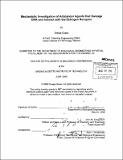| dc.contributor.advisor | John M. Essigmann. | en_US |
| dc.contributor.author | Gopal, Sreeja | en_US |
| dc.contributor.other | Massachusetts Institute of Technology. Dept. of Biological Engineering. | en_US |
| dc.date.accessioned | 2011-02-23T14:32:04Z | |
| dc.date.available | 2011-02-23T14:32:04Z | |
| dc.date.copyright | 2009 | en_US |
| dc.date.issued | 2009 | en_US |
| dc.identifier.uri | http://hdl.handle.net/1721.1/61223 | |
| dc.description | Thesis (Ph. D.)--Massachusetts Institute of Technology, Dept. of Biological Engineering, 2009. | en_US |
| dc.description | Cataloged from PDF version of thesis. | en_US |
| dc.description | Includes bibliographical references. | en_US |
| dc.description.abstract | One of the primary goals of cancer chemotherapy is the design of antitumor agents that achieve selective targeting of tumor cells while minimizing toxicity to normal tissues. We have synthesized a series of DNA damaging agents that are designed to disrupt selectively the DNA repair and signaling pathways in tumor cells. My dissertation focuses on the mechanistic studies of the rationally designed genotoxicants E2-7aX and 2Pl, which target cancer cells that express the estrogen receptor (ER). The studies on the biological activity of E2-7ca in ovarian cancer cells reveal that the compound induces levels of cytotoxicity comparable to those of cisplatin, which is the current front-line therapeutic for ovarian cancer. E2-7ca induces crosslink formation in the ovarian cell line SKOV-3, which potentially leads to the S-phase arrest observed in these cells. Further, the arrest is persistent even after drug removal, indicating that the persistence might be one of the reasons for the enhanced toxicity of E2-7ca compared to the control compound chlorambucil. E2-7ca induces cell death in SKOV-3 cells through autophagy, as opposed to the classical cell death pathway of apoptosis. Mechanistic studies on the role of ER in E2-7a toxicity in SKOV-3 cells show that the absence of the ER (facilitated by the knockdown of ER protein through RNA interference in SKOV-3 cells) makes the cells less sensitive to the drug. In addition, the ER(-) population displays a lower level of drug- DNA adducts than its ER(+) counterpart, as detected by Accelerator Mass Spectrometry (AMS). The combination of these pieces of evidence strongly suggests that as per its intended mechanism of action, E2-7a. mediates its effects through the involvement of the ER, and appears to be a promising candidate as an antitumor agent in the clinical setting. In addition, the toxicity and DNA damage caused by the 2-phenylindole compounds 2PI and 2PI(OH) were studied in ovarian cancer cell lines; these studies underscore the differences in the mechanism of action of the two compounds. Both the compounds demonstrate promise as potent anti-tumor agents, and the selectivity of these compounds in different cellular contexts (ER (+)/(-) or p53 (+)/(-)), once established, could help strengthen the basis of their therapeutic efficacy. | en_US |
| dc.description.statementofresponsibility | by Sreeja Gopal. | en_US |
| dc.format.extent | 270 p. | en_US |
| dc.language.iso | eng | en_US |
| dc.publisher | Massachusetts Institute of Technology | en_US |
| dc.rights | MIT theses are protected by copyright. They may be viewed, downloaded, or printed from this source but further reproduction or distribution in any format is prohibited without written permission. | en_US |
| dc.rights.uri | http://dspace.mit.edu/handle/1721.1/7582 | en_US |
| dc.subject | Biological Engineering. | en_US |
| dc.title | Mechanistic investigation of anticancer agents that damage DNA and interact with the estrogen receptor | en_US |
| dc.type | Thesis | en_US |
| dc.description.degree | Ph.D. | en_US |
| dc.contributor.department | Massachusetts Institute of Technology. Department of Biological Engineering | |
| dc.identifier.oclc | 701497590 | en_US |

